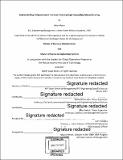| dc.contributor.advisor | David Simchi-Levi and Roy Welsch. | en_US |
| dc.contributor.author | Myers, Julius (Julius Scott) | en_US |
| dc.contributor.other | Leaders for Global Operations Program. | en_US |
| dc.date.accessioned | 2017-09-15T15:38:28Z | |
| dc.date.available | 2017-09-15T15:38:28Z | |
| dc.date.copyright | 2017 | en_US |
| dc.date.issued | 2017 | en_US |
| dc.identifier.uri | http://hdl.handle.net/1721.1/111535 | |
| dc.description | Thesis: M.B.A., Massachusetts Institute of Technology, Sloan School of Management, in conjunction with the Leaders for Global Operations Program at MIT, 2017. | en_US |
| dc.description | Thesis: S.M. in Engineering Systems, Massachusetts Institute of Technology, School of Engineering, Institute for Data, Systems, and Society, in conjunction with the Leaders for Global Operations Program at MIT, 2017. | en_US |
| dc.description | Cataloged from PDF version of thesis. | en_US |
| dc.description | Includes bibliographical references (pages 60-61). | en_US |
| dc.description.abstract | Aircraft Company X (AX) manufactures and assembles an immense variety of parts utilized as drive systems and rotor components across its multiple aircraft. The company's value proposition is maintaining the ability to build and service all legacy parts and as a result there is a great deal of variety found in its manufacturing processes. This variety stems from upgrades to manufacturing technology, improvements in material science, design variations, and individual part engineering modifications. In order to be responsive to fluctuating demand while minimizing costs, AX must broadly implement postponement into numerous applications as a way to extract the most value from its resources. This thesis uses multiple applications of postponement within AX to establish a methodology that can be used across various materials, both metallic and non-metallic. This methodology guided implementation of postponement through material physical form consolidation, material substitutions, and even provided insight into which manufacturing technique given a particular material form is optimal. The benefits are numerous to include a roughly 30% inventory reduction, improved buying power resulting in cost savings of over 10%, a reduction of material shortages by over 40%, and shorter lead times for finished goods. Extensions of these applications include aligning AX's supply chain with its suppliers utilizing identified tolerances and adding layers of postponement beyond raw material inputs. | en_US |
| dc.description.statementofresponsibility | by Julius Myers. | en_US |
| dc.format.extent | 61 pages | en_US |
| dc.language.iso | eng | en_US |
| dc.publisher | Massachusetts Institute of Technology | en_US |
| dc.rights | MIT theses are protected by copyright. They may be viewed, downloaded, or printed from this source but further reproduction or distribution in any format is prohibited without written permission. | en_US |
| dc.rights.uri | http://dspace.mit.edu/handle/1721.1/7582 | en_US |
| dc.subject | Sloan School of Management. | en_US |
| dc.subject | Institute for Data, Systems, and Society. | en_US |
| dc.subject | Engineering Systems Division. | en_US |
| dc.subject | Leaders for Global Operations Program. | en_US |
| dc.title | Implementing postponement into low-volume/high-variability manufacturing | en_US |
| dc.type | Thesis | en_US |
| dc.description.degree | M.B.A. | en_US |
| dc.description.degree | S.M. in Engineering Systems | en_US |
| dc.contributor.department | Leaders for Global Operations Program at MIT | en_US |
| dc.contributor.department | Massachusetts Institute of Technology. Engineering Systems Division | |
| dc.contributor.department | Massachusetts Institute of Technology. Institute for Data, Systems, and Society | |
| dc.contributor.department | Sloan School of Management | |
| dc.identifier.oclc | 1003324609 | en_US |
